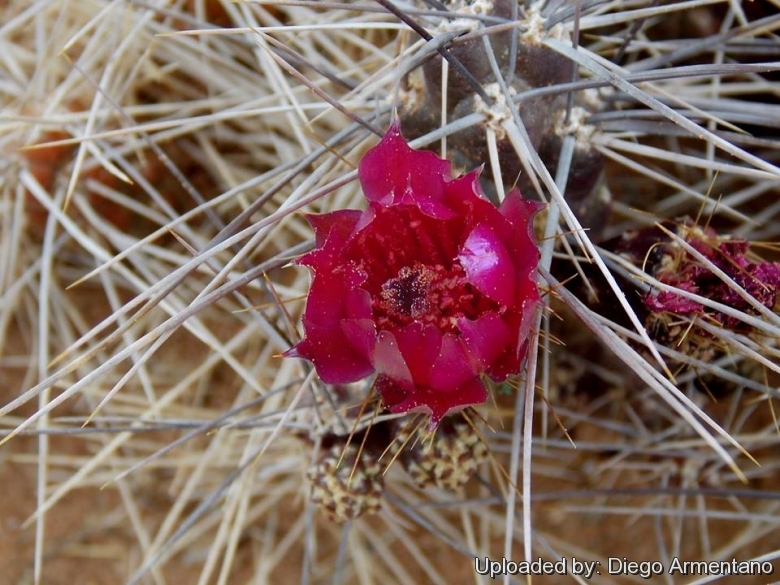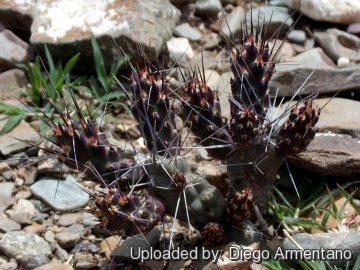Accepted Scientific Name: Maihueniopsis nigrispina (K.Schum.) R.Kiesling
Darwiniana 25(1–4): 209 1984.

Pseudomaihueniopsis nigrispina (Maihueniopsis nigrispina) Photo by: Diego Armentano
Origin and Habitat: The main habitat of Maihueniopsis nigrispinaSN|32593]]SN|32593]] is the Argentinian puna, through Salta and Jujuy provinces and into south Bolivia. There is also a disjunct population in Tarapacá and Antofagasta, Chile and Oruro, Bolivia. The species is locally abundant in its main area of distribution. It is not abundant in Chile.
Altitude range: 3,400 and 3,700 metres above sea level.
Habitat and Ecology: This cactus occurs on sandy grounds in the puna. The species is not utilized and there are no known threats.
Synonyms:
See all synonyms of Maihueniopsis nigrispina
back
Accepted name in llifle Database:Maihueniopsis nigrispina (K.Schum.) R.KieslingDarwiniana 25(1–4): 209 1984.Synonymy: 10
back
Common Names include:
ENGLISH: airampo, airampu
Description: Maihueniopsis nigrispinaSN|20943]]SN|32593]] is a shrubby, moderately or sometimes densely branched, cactus species forming, hemispheric clumps of loosely arranged segments 1-2 metres wide. Unlike Maihueniopsis darwiniiSN|32593]]SN|20943]], this species is self-fertile, producing fruits which are bright pink and sweet- tasting when ripe. In this and other respects it appears quite distinct from anything else previously included in the very broad genus Tephrocactus sensu Backeberg.
Derivation of specific name: The epithet 'nigrispinus,-a,-um'; from Latin 'niger, nigra, nigrum', black, and Latin '-spinus', -spined, refers to the purplish-black spines.
Stem segments: More or less upright, of determinate growth, oblong to ellipsoidal, to 4 cm, or shorter and subglobose, round in cross section, dull green or reddish violet, tuberculate when young, spiny above.
Areoles: 2-3 mm in diameter, with abundant wool and glochids.
Spines: 3-5, borne on upper areoles, acicular, straight, spreading, weak, purplish black or not, 2.5-5 cm long.
Flowers: Dark red to purple (or brilliant scarlet), 2-2.5 cm long. Pericarpel with little wool and 1–2 bristles in the axils of the few bract-scales, apparently sometimes with areoles at rim.
Fruits: Indehiscent, with 4–5 small areoles on, or near the rim, the few lower nodes bearing minute tufts of wool, epidermis and flesh dark red, soft, juicy and sweet.
Seeds: Reniform, hard, sharply sculptured.
Subspecies, varieties, forms and cultivars of plants belonging to the Maihueniopsis nigrispina group
 Maihueniopsis nigrispina (K.Schum.) R.Kiesling: has ovoid to elongate segments; spines often dark, flower deep crimson.
Maihueniopsis nigrispina (K.Schum.) R.Kiesling: has ovoid to elongate segments; spines often dark, flower deep crimson.- Opuntia atroglobosa (F.Ritter) R.Crook & Mottram: has globose to short-ovoid segments; spines whitish; flower brilliant scarlet.
Bibliography: Major references and further lectures
1) Hunt, D., Taylor, N. and Charles, G. “The New Cactus Lexicon.” dh Books, Milborne Port, UK. 2006
2) David R. Hunt “Studies in the Opuntioideae (Cactaceae)” D. Hunt, 2002
3) Edward Anderson “The Cactus family” Timber Press, Incorporated, 2001
4) Pinto, R. “Maihueniopsis nigrispina (Cactaceae, Opuntioideae)” nuevo registro para la flora chilena. Chloris Chilensis. 6(1): 1-5. 2003.
5) British Cactus & Succulent Journal, Cactus & Succulent Society, page xxxix, 1993
6) Urs Eggli, Leonard E. Newton “Etymological Dictionary of Succulent Plant Names" Springer Science & Business Media, 29 June 2013
7) Lowry, M. 2013. Tephrocactus nigrispinus. The IUCN Red List of Threatened Species 2013: e.T152082A595111. . Downloaded on 27 February 2016.
 Pseudomaihueniopsis nigrispina (Maihueniopsis nigrispina) Photo by: Diego Armentano
Pseudomaihueniopsis nigrispina (Maihueniopsis nigrispina) Photo by: Diego ArmentanoSend a photo of this plant.The gallery now contains thousands of pictures, however it is possible to do even more. We are, of course, seeking photos of species not yet shown in the gallery but not only that, we are also looking for better pictures than those already present.
Read More... Cultivation and Propagation: Maihueniopsis nigrispinaSN|32593]]SN|32593]] is an easy-to-grow plant supposed to be quite cold-hardy in the central European countries. It can survive outside in the garden in the sunny rockery on a sheltered place, but only if it's protected with a sheet of glass during the wintertime. It is also very good for a pot which can be stored inside an unheated greenhouse or on a balcony, somewhat protected from moisture during the winter, but is probably safest to grow it in the Alpine House or in a raised bed inside an unheated greenhouse all year around, with lots of ventilation. It, too, deserves to be drawn to the attention of trough enthusiasts, as it is a unique and attractive miniature that could remain in the same container for life. The plant is very slow growing besides being small.
Potting medium: It has a carrot-sized taproot and does best in garden loam that is gritty, but not rocky. In pots use a cactus mix or add extra perlite or pumice to regular soil potting soil. A gritty, very free-draining compost is suitable, and clay pots help the plants to dry out between watering. For best results, use a deep pot. We suggest repotting every 2-3 years.
Fertilization: During the beautiful season it’s good to enrich the soil of our succulent plants; using a fertilizer rich in potassium and phosphorous, but poor in nitrogen, because this chemical element doesn’t help the development of succulent plants, making them too soft and full of water.
Hardiness: It doesn't fear cold weather and it bears very harsh frost, and temperatures of around -10° degrees Celsius did not harm these plants at all. They should not be kept hot in summer as they are from high elevations. In its high mountain habitats this charming, little cactus is often buried under snow for long periods of winter. It does not require such a covering, but the plant is better able to survive without cold damage when a layer of mulch protects it if there is not snow cover during the harshest months.
Sun Exposure: It is essential to give full sun; otherwise they will become atypical. If grown in full sun, the new growth will flower profusely in spring and summer.
Watering: These plants only from time to time if grown outdoors, but it should be watered abundantly if grown in a pot or in the greenhouse, during the summer. Like most alpine plants, it should not be kept excessively dry in summer.
Pest and diseases. The spring weather, with a high temperature swing between the day and night hours, and pretty frequent rains, can favour the development of fungus diseases, which should be treated pre-emptively with a systemic fungicide.











